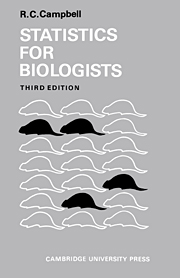Book contents
- Frontmatter
- Contents
- PREFACE
- PREFACE TO SECOND EDITION
- PREFACE TO THIRD EDITION
- 1 WHAT IS STATISTICS ABOUT?
- 2 PRESENTING THE INFORMATION CONTAINED IN ONE SAMPLE
- 3 COMPARING SEVERAL SAMPLES
- 4 ASSOCIATION
- 5 CHOOSING BETWEEN ACTIONS
- 6 THE NORMAL DISTRIBUTION
- 7 THE NORMAL VARIABLE IN EXPERIMENTS AND SURVEYS
- 8 ASSOCIATED NORMAL VARIABLES
- 9 SOME NON-NORMAL DISTRIBUTIONS
- FURTHER READING
- REFERENCES
- APPENDIX: TABLES AND FIGURES FOR STATISTICAL TESTS AND EXERCISES
- INDEX
4 - ASSOCIATION
Published online by Cambridge University Press: 05 June 2012
- Frontmatter
- Contents
- PREFACE
- PREFACE TO SECOND EDITION
- PREFACE TO THIRD EDITION
- 1 WHAT IS STATISTICS ABOUT?
- 2 PRESENTING THE INFORMATION CONTAINED IN ONE SAMPLE
- 3 COMPARING SEVERAL SAMPLES
- 4 ASSOCIATION
- 5 CHOOSING BETWEEN ACTIONS
- 6 THE NORMAL DISTRIBUTION
- 7 THE NORMAL VARIABLE IN EXPERIMENTS AND SURVEYS
- 8 ASSOCIATED NORMAL VARIABLES
- 9 SOME NON-NORMAL DISTRIBUTIONS
- FURTHER READING
- REFERENCES
- APPENDIX: TABLES AND FIGURES FOR STATISTICAL TESTS AND EXERCISES
- INDEX
Summary
The idea of association
In the methods discussed in earlier chapters we have shown how to summarize one sample and how to compare two or more samples, but in every case we have supposed that we are dealing with only one variable. This is a reasonable starting point, but many new and interesting problems require attention if we observe more than one facet of our material. Thus in our earliest discussion of green grass, we could well have considered how the greenness was related to, say, the botanical composition of the sward; in considering the fattening period of bacon pigs (2.2.1) we might reasonably have asked how this period was related to each animal's weight at the start. In both these cases, and in many others, we should be interested in the association between two or more variables; the purpose of this chapter is to describe some of the methods available for the analysis of association.
We shall consider three main groups of methods. The first (4.2) is used when the observations are counts (frequencies); the second and third apply to measured variables, the second (4.3) being a simple test of correlation and the third (chapter 8) giving more precise information about the form of the relationship.
An example of a 2 x 2 contingency table
Suppose we wish to test the usefulness of a measles vaccine in a group of 200 children.
- Type
- Chapter
- Information
- Statistics for Biologists , pp. 107 - 135Publisher: Cambridge University PressPrint publication year: 1989
- 1
- Cited by



